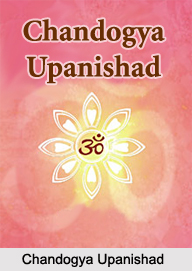 Chandogya Upanishad, written on the Vedic Brahmana is one of the oldest Upanishads. It is related with Sama Veda. Chandogya Upanishad is the part of Chandogya Brahaman that has eight chapters. The 10th Khanda of second chapter of Chandogya Upanishad states about the meditation on the sevenfold Saman by the number of syllables. According to it one must meditate on the sevenfold Saman that has a uniform number of syllables. These help one to go beyond death. Here the word Himkara has three syllables as well as the word Prastava has three syllables. They both are thus, equal. Again the word Adi consists of two syllables and the word Pratihara consists of four syllables. Here, if one syllable is taken away from Pratihara and joined with Adi, they become equal i.e. sama. The word Upadrava has four syllables and the word Udgitha has three syllables. The three and three syllables become equal. If one syllable is left out it becomes trisyllabic. The word Nidhana has three syllables; hence it is equal. All these together make twenty two syllables of the sevenfold Saman. One can reach the sun with these twenty one syllables as the sun is the twenty first from here. With the twenty second he conquers that goes beyond the sun. That plane beyond the sun is blessed and is devoid of grief. One who understands this and meditates on the sevenfold Saman that has a uniform number of syllables and that leads beyond death is able to obtain victory over the sun i.e. death.
Chandogya Upanishad, written on the Vedic Brahmana is one of the oldest Upanishads. It is related with Sama Veda. Chandogya Upanishad is the part of Chandogya Brahaman that has eight chapters. The 10th Khanda of second chapter of Chandogya Upanishad states about the meditation on the sevenfold Saman by the number of syllables. According to it one must meditate on the sevenfold Saman that has a uniform number of syllables. These help one to go beyond death. Here the word Himkara has three syllables as well as the word Prastava has three syllables. They both are thus, equal. Again the word Adi consists of two syllables and the word Pratihara consists of four syllables. Here, if one syllable is taken away from Pratihara and joined with Adi, they become equal i.e. sama. The word Upadrava has four syllables and the word Udgitha has three syllables. The three and three syllables become equal. If one syllable is left out it becomes trisyllabic. The word Nidhana has three syllables; hence it is equal. All these together make twenty two syllables of the sevenfold Saman. One can reach the sun with these twenty one syllables as the sun is the twenty first from here. With the twenty second he conquers that goes beyond the sun. That plane beyond the sun is blessed and is devoid of grief. One who understands this and meditates on the sevenfold Saman that has a uniform number of syllables and that leads beyond death is able to obtain victory over the sun i.e. death.
This article is a stub. You can enrich by adding more information to it. Send your Write Up to content@indianetzone.com



















